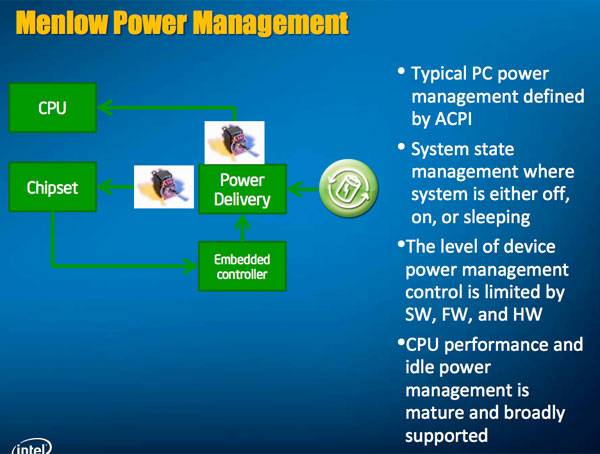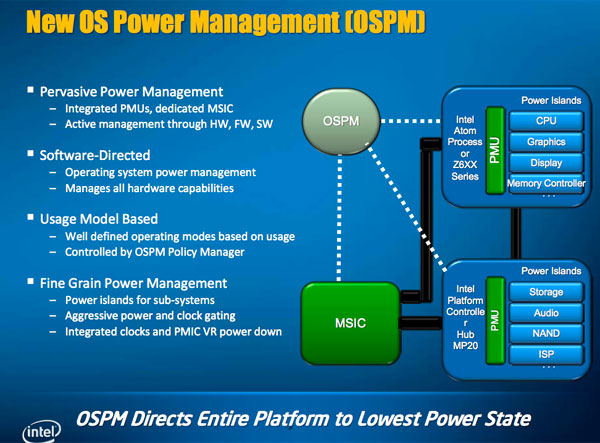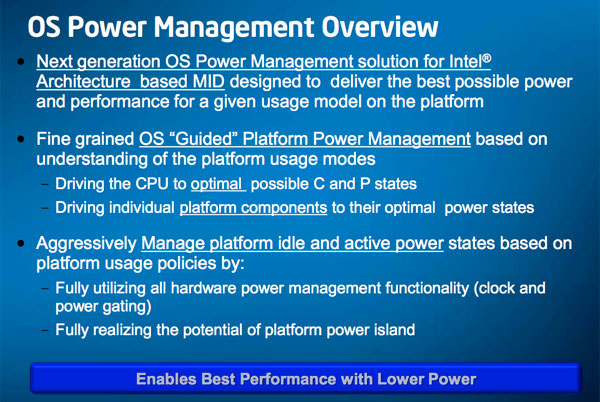Intel Unveils Moorestown and the Atom Z600, The Fastest Smartphone Platform?
by Anand Lal Shimpi on May 4, 2010 11:54 PM EST- Posted in
- Smartphones
- Intel
- Atom
- Mobile
- SoCs
OS Driven Power Management
When Intel introduced Nehalem and the Core i7, we saw a new generation of power engineering in microprocessors. In the past, the OS would request a particular performance state from the CPU and the chip would respond by changing its clock speed. Nehalem’s Power Control Unit (PCU) instead dedicated enough transistors to build a 486 to monitoring the power and performance demands on the chip. Based on those demands and what the OS was doing, the PCU would power up or down individual cores, as well as move clock speeds up or down. The PCU would guess at what the OS was trying to do and respond accordingly.
Nehalem and its successors were massive chips, eating up to 130W of power under load and idling down in the 6 - 10W range. Lincroft has to be sub-1W under load and 6mW at idle. With even more stringent power demands and a much smaller die, Intel couldn’t blow a sizeable percentage of the Lincroft transistor budget on power management.

Instead of guessing at what the OS wants, the Moorestown platform uses OS Driven Power Management (OSPM) to tell Lincroft and Langwell what to do. OSPM is supported in Moblin and presumably the Wind River build of Android.

The OSPM process tells the hardware what apps it’s running and to shut down what it doesn’t need. There are well defined operating modes - standby, internet browsing, MP3 playback, video playback, voice call, video capture, etc... Based on the profile, the hardware doesn’t have to guess at what it should turn off/on, it just does it right away.
The OSPM driver communicates directly with the two power management units in Moorestown - one in Lincroft and one in Langwell. It instructs those PMUs to shut off various blocks, and in turn they tell Briertown to gate and cut voltage to the parts of chip that aren’t needed.

I wondered if this couldn’t be done in hardware, but it seems that given current die constraints and the sort of accuracy of information it needs Intel must implement at least some of the power management control in software. Toolkits will be available for developers to control the OSPM.










67 Comments
View All Comments
teohhanhui - Thursday, May 6, 2010 - link
But they'll be showcasing it on their Moblin/Meego which is Linux. Won't shoot themselves in the feet, will they?rahvin - Thursday, May 6, 2010 - link
And if it only runs on Moblin, only with specific kernel versions, uses a binary blob driver and isn't maintained it will be the same story as GMA500 all over again.strikeback03 - Thursday, May 6, 2010 - link
As pointed out, plenty of other Android phones are using the same graphics. And I haven't heard a lot of complaints about lack of drivers for the Droid/N1/etc.elisha.pan - Wednesday, May 5, 2010 - link
GMA500 has nothing with the Intel GMA series, but name. It is exactly the same with PowerVR SGX 535.DanNeely - Wednesday, May 5, 2010 - link
This is the same GPU used in almost every other smart phone on the market, except that it's designed to be clocked up to twice as fast. It's not going to run Crysis *rolls eyes* but it's more than capable of doing everything a smart phone/internet tablet will need to do.ekul - Wednesday, May 5, 2010 - link
exactly. without open source drivers for the graphic any development of meego outside of intel will never go anywhere. One of the reasons I bought my current netbook is the gma 950 has excellent open source drivers that just work.Open source development moves fast. Closed source binaries get left behind because they can't keep up with the release schedule. The current gma 500 drivers already need a kernel several versions old as well as an old X server. How many releases is meego going to miss?
ViRGE - Wednesday, May 5, 2010 - link
I can see why Anand thinks it's an interesting product, but based on his article I don't think Intel is quite there.The current need for 5 chips is going to be a problem no matter how Intel dresses things up, and if all phones end up looking like the design shown I wouldn't be surprised if the consumer reaction was tepid - a phone of that size is still pretty big. The video playback time is also going to be a problem when it comes to spec sheets (I doubt the real-world impact will be as huge), but OEMs like their spec sheets and consumers aren't too far off either. Just looking like it'll perform poorly there may be enough.
The other issue is the reliance on an OS. At this point it seems like no one really wants another OS. Most people around here seemed to be more relieved than concerned when Palm went under. With BlackBerryOS, IPhoneOS, Android, and WinCE, there seems to be as many OSes as the market can reasonably handle. Moblin/MeeGo may be necessary for the hardware right now, but I see no reason to expect that it's going to be properly developed for consumer use like the above OSes were. Unless Intel can land RIM/Apple, they need to get Android up to par on Moorestown and they need to do it yesterday.
Ultimately I think it's going to Medfield that's a proper ARM competitor. With fewer chips it will fit in to traditional designs, and with any luck Intel will be a node ahead of its competition on the manufacturing process. It won't solve the current OS reliance, but it'll put them in a better position than Moorestown does.
ET - Wednesday, May 5, 2010 - link
Ultimately I think that most people don't care about the OS. The OS mainly matters in terms of applications available for it, and it's a pain for developers to address many OS's, but also an opportunity for new developers to carve their niche.That said, Anand did mention that Intel is making Android available for this new platform, which should be good enough.
IntelUser2000 - Wednesday, May 5, 2010 - link
It's much closer than expected. There were quite frequent comments that thought it wouldn't even reach 5 hour on standby! Having a lot of knowledge and doing a bit research helps of course. Glad they can be roughly on par though.It's likely the idle power can't be achieved without optimized OSes. Even if you can run Windows on it, what's the point when you won't have the battery life for it? Windows uses too much on keeping legacy support and its too bloated for idle power under 50mW.
Platform approach is the key to low power on Moorestown.
piroroadkill - Wednesday, May 5, 2010 - link
I'm not sold. ARM has been more efficient for a lot longer, even though it's still being made on commonly larger processes than current Intel CPUs. All smartphones are ARM anyhow, so I don't see the advantage in having x86 in this space